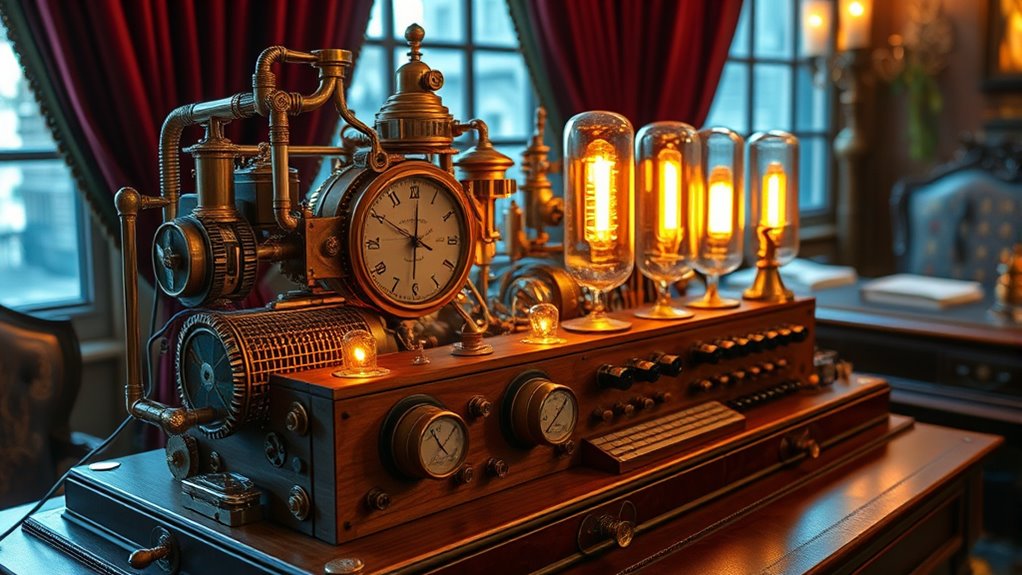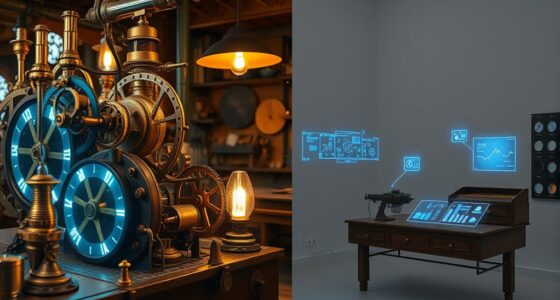Steampunk computing blends Victorian charm with modern technology, creating enchanting machines that capture your imagination. Imagine intricate designs featuring brass, copper, and wood, complete with visible gears and clockwork elements. Influenced by writers like H.G. Wells, these fantastical devices express innovation and exploration. As you explore this captivating movement, you'll uncover the fascinating materials and craftsmanship that define steampunk. There's much more to discover about its vibrant community and future innovations waiting to be unveiled.
Key Takeaways
- Steampunk computers blend vintage aesthetics with modern technology, using materials like brass, copper, and wood for a nostalgic appearance.
- Visible gears and clockwork components symbolize mechanical complexity, reflecting the ingenuity of Victorian-era engineering.
- Design elements often include leather accents and intricate carvings, enhancing the luxurious feel reminiscent of Victorian craftsmanship.
- The influence of Victorian literature, particularly themes of innovation and exploration, shapes the narrative behind steampunk computing.
- Future innovations in steampunk computing may prioritize sustainability, incorporating eco-friendly materials and advanced technologies like 3D printing.
The Aesthetic Appeal of Steampunk Computers
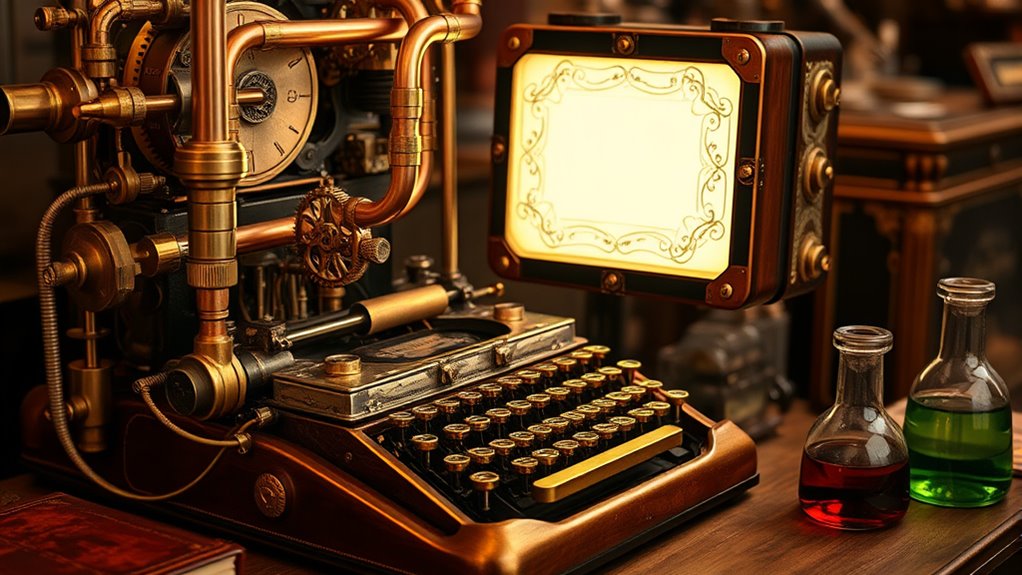
The aesthetic appeal of steampunk computers captivates enthusiasts with their unique blend of vintage charm and modern technology.
You'll find materials like brass, copper, and wood that evoke a nostalgic feel, while visible gears and clockwork components create a mechanical complexity that's hard to resist.
Leather accents add a luxurious touch, enhancing the Victorian-era vibe. Steampunk aesthetics can be further enhanced with unique accessories that complement the overall design.
Decorative fixtures showcase detailed craftsmanship, elevating the overall design.
Vintage-inspired peripherals, such as keyboards and mousepads, resemble historical devices, making your setup truly one-of-a-kind.
This retrofuturism appeals to those who value individuality and creativity, allowing you to express your imagination while engaging with contemporary tech.
Steampunk computers don't just serve a purpose; they tell a story, inviting you into a world of artistic innovation.
Key Influences From Victorian Literature
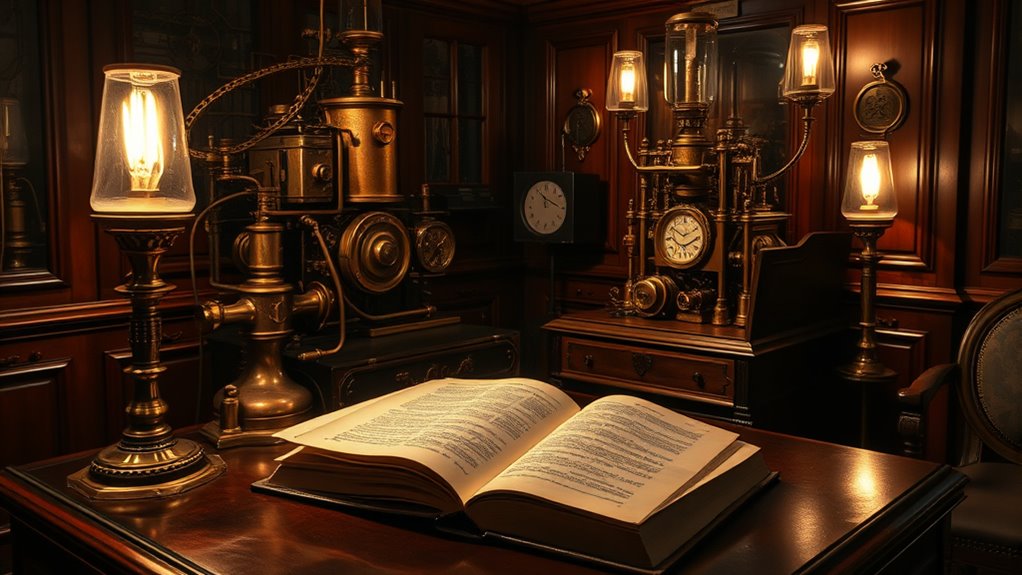
While exploring the world of steampunk computing, you'll notice how deeply rooted it's in Victorian literature. Authors like H.G. Wells and Jules Verne sparked your imagination with tales of time travel and futuristic inventions. Their ideas about advanced machinery inspire countless steampunk gadgets. The concept of emotional intelligence is particularly relevant in these narratives, as characters often navigate complex relationships shaped by their social environments.
Charles Dickens provides a rich social backdrop, reflecting class struggles that resonate in steampunk narratives. Bram Stoker's "Dracula" adds a supernatural twist, while Oscar Wilde's wit enriches the genre's aesthetic. The influence of steam engines in these stories serves as a technological cornerstone that enhances the steampunk experience. Additionally, the notion of cryptid mysteries fascinates the genre, as the blend of the unexplained with technology evokes a sense of wonder and curiosity.
These literary influences shape themes of innovation, exploration, and the human condition, driving steampunk's unique storytelling. As you delve into this genre, you'll appreciate how these classic works help create a vibrant, alternate reality where Victorian ideals meet modern creativity.
The Role of Steam Power in Technology
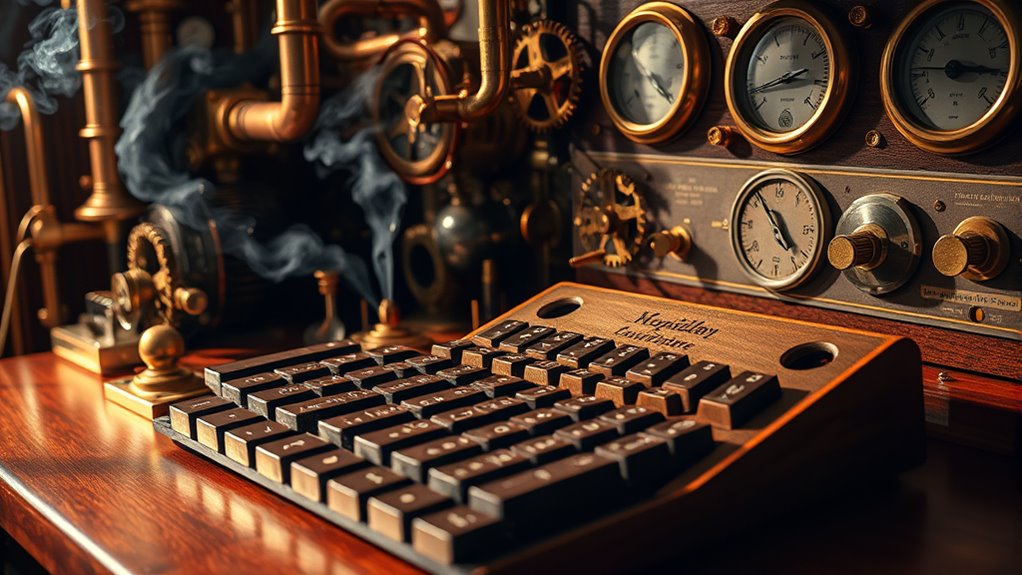
Steampunk computing not only draws inspiration from Victorian literature but also pays homage to the revolutionary technology of steam power.
You can trace its origins back to Thomas Savery's 1698 patent for mining and Thomas Newcomen's 1712 steam engine, which paved the way for water pumping. James Watt's enhancements in the 18th century transformed steam engines into industrial powerhouses. These engines fueled the Industrial Revolution, replacing traditional energy sources. You'll find steam engines pivotal in electricity generation, marine propulsion, and even nuclear power plants. Charles Parsons' introduction of the modern steam turbine in the late 19th century further advanced the efficiency of steam power, enabling its widespread application in various industries.
As you explore steampunk's aesthetic, remember that steam technology continues to evolve, with modern advancements focusing on sustainability and efficiency, ensuring its relevance in today's world.
Materials That Define Steampunk Design
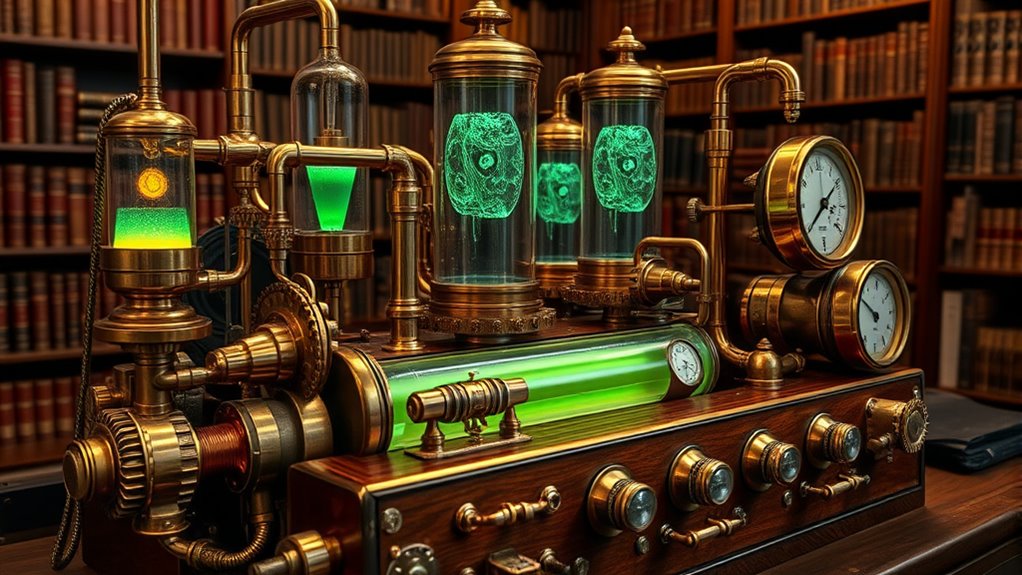
Crafting a steampunk aesthetic relies heavily on a unique selection of materials that evoke the era's charm and industrial innovation.
You'll often find brass, copper, and iron taking center stage, showcasing their rich textures and colors. Dark woods like mahogany or oak contribute intricately carved details, while leather adds a luxurious touch to furniture. Incorporating vintage elements like old clocks and gears enhances authenticity. Don't forget to blend materials for depth; exposed cogwheels and clockwork mechanisms create striking visual contrasts. Successful projects require a focal point to draw attention and enhance the overall design of your steampunk creations.
Vintage lighting with brass fixtures illuminates your design, while a dark color palette sets the mood. Experiment with rust and patina effects to bring a sense of age and character, making your steampunk creations truly unique.
Functionality Meets Fantasy: Modern Applications
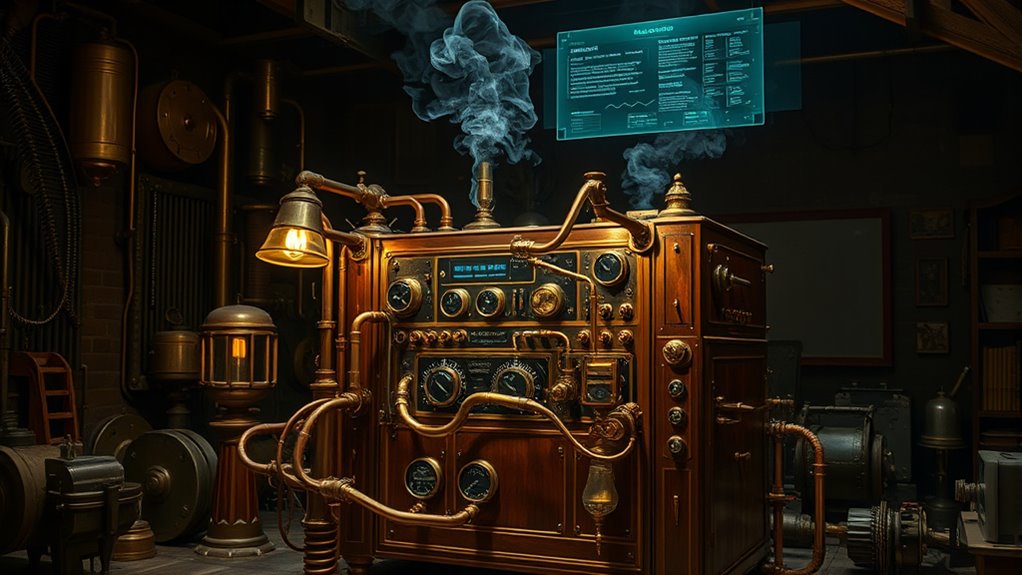
The unique materials and intricate designs of steampunk not only evoke a sense of nostalgia but also pave the way for modern applications that fuse functionality with fantasy. You can combine steampunk aesthetics with modern hardware, like Raspberry Pi, to create imaginative devices, from interactive name badges to home automation systems. Drawing inspiration from historical innovations, steampunk allows you to blend the past with the present. This DIY culture encourages you to enhance existing technologies, resulting in visually striking and functional creations. In education, steampunk helps explain complex concepts, such as quantum physics, through engaging narratives, drawing a parallel to how astrology influences attractiveness and self-image. Additionally, the integration of nano-sized Linux boards enables creators to explore new dimensions of interactivity in their projects. For example, using sleek designs and innovative materials, you can create freshly squeezed juices that not only look great but also provide delicious, healthy options for gatherings. Furthermore, incorporating elements of color accuracy into your steampunk designs can enhance the overall wellness experience of your creations. Moreover, incorporating elements of hydration and nutrition into your steampunk designs can enhance the overall wellness experience of your creations.
Community and Culture in the Steampunk Movement

While exploring the vibrant world of steampunk, you'll find a rich tapestry of community and culture that thrives on collaboration and creativity.
The term "steampunk," coined by K.W. Jeter in the 1980s, opened a door to a culture influenced by goth and neo-Victorian aesthetics. Events like Steamcon and the Steampunk World's Fair gather enthusiasts, featuring artists, musicians, and authors like Phenderson Djèlí Clark and Professor Elemental.
Steampunk, a vibrant culture blending goth and neo-Victorian aesthetics, thrives at events like Steamcon and the Steampunk World's Fair.
The Malediction Society pioneered steampunk-themed nightlife, while SalonCon hosted engaging panels and performances. This community embraces individuals of all ages, genders, abilities, and ethnic backgrounds, rejecting the inequalities of the Victorian past.
Fashion blends Victorian elegance with modern flair, showcasing unique artistic expressions. This community fosters connections, encouraging diverse narratives and celebrating creativity, making it a dynamic and inclusive movement you can't help but admire.
The Future of Steampunk Innovations

Steampunk enthusiasts are already pushing boundaries in design and technology, and the future promises even more intriguing innovations.
You'll likely see 3D printing play a significant role, allowing you to create custom components that enhance repair and personalization. This aligns with the importance of high-quality equipment in ensuring that your steampunk creations function effectively. As the focus on sustainable living grows, creators will increasingly seek methods to incorporate eco-friendly practices into their projects. Additionally, the rise of seed-based diets in modern food culture may inspire steampunk creators to experiment with innovative materials sourced from nature. Airless sprayers, for example, can offer a smooth finish that enhances the aesthetic appeal of steampunk designs.
As the movement evolves, you might notice a dieselpunk influence, merging elements from the 1920s to 1950s, further diversifying steampunk aesthetics. This evolution reflects the nostalgia for a time when technological creativity was at the forefront, drawing inspiration from the past.
Expect steampunk to expand beyond computers into unique gadgets, like smartwatches, blending historical charm with modern functionality. Innovations in sound recording techniques will also contribute to the immersive experiences offered by these gadgets.
Sustainability concerns will also shape innovations, encouraging the use of eco-friendly materials.
As these trends unfold, you'll enjoy a fascinating fusion of the past and future, making steampunk computing an ever-evolving realm of creativity and technology.
Frequently Asked Questions
How Can I Build My Own Steampunk Computer?
To build your own steampunk computer, start by selecting a wooden box as your case.
Modify it to fit modern components while adding brass fittings and vintage gauges for that Victorian flair. Use copper pipes for cooling and incorporate gears for decoration.
Choose energy-efficient parts to keep it eco-friendly, and don't forget to add unique features like antique light bulbs.
This way, you'll create a stunning blend of old and new technology.
Are There Workshops for Steampunk Computer Enthusiasts?
Picture yourself stepping into a realm where gears and gadgets whirl in a dance of creativity.
Yes, there are workshops tailored for steampunk computer enthusiasts like you! These hands-on experiences allow you to immerse yourself in crafting unique devices while learning from seasoned instructors.
You'll explore material selection and craftsmanship techniques, wielding tools like screwdrivers and soldering irons, transforming vintage elements into stunning, functional art.
Get ready to unleash your inner inventor!
What Are the Best Resources for Learning Steampunk Design?
To dive into Steampunk design, you'll want to explore a mix of resources.
Start with books on Victorian literature for foundational inspiration. Websites like AIRSHIPS.NET offer valuable technical insights.
Historical fashion guides help you create authentic settings. Online galleries showcase stunning Steampunk art for visual ideas.
Finally, check out the EBSCO eBook Collection for a variety of titles on Steampunk topics to deepen your understanding and spark your creativity.
Can Steampunk Computers Be Used for Gaming?
Absolutely, you can use steampunk computers for gaming!
These unique builds combine high-performance components like powerful graphics cards and custom cooling systems, ensuring you get a smooth gaming experience. The aesthetic appeal adds a nostalgic vibe to your setup, making it visually striking.
Just keep in mind that creating a steampunk gaming PC requires careful planning and craftsmanship, but the result can be a beautiful and functional centerpiece for your gaming room.
How Do I Connect Modern Peripherals to a Steampunk Computer?
Did you know that 70% of people prefer devices that combine aesthetics with functionality?
To connect modern peripherals to your Steampunk computer, start by checking for USB compatibility. Use adapters or converters to bridge any gaps.
Consider peripherals made from bamboo or those with brass finishes to maintain your theme. Custom casings can also enhance the look while ensuring everything works smoothly.
With some creativity, you can achieve both style and performance!
Conclusion
In embracing steampunk computing, you're not just celebrating a unique aesthetic; you're also fostering creativity and innovation. While some might argue that this genre romanticizes outdated technology, the fusion of Victorian design with modern functionality sparks new ideas and pushes boundaries. By envisioning a future where art and science intertwine, you're contributing to a vibrant community that values imagination as much as practicality. So, indulge in the fantastical—there's no limit to what you can create!
